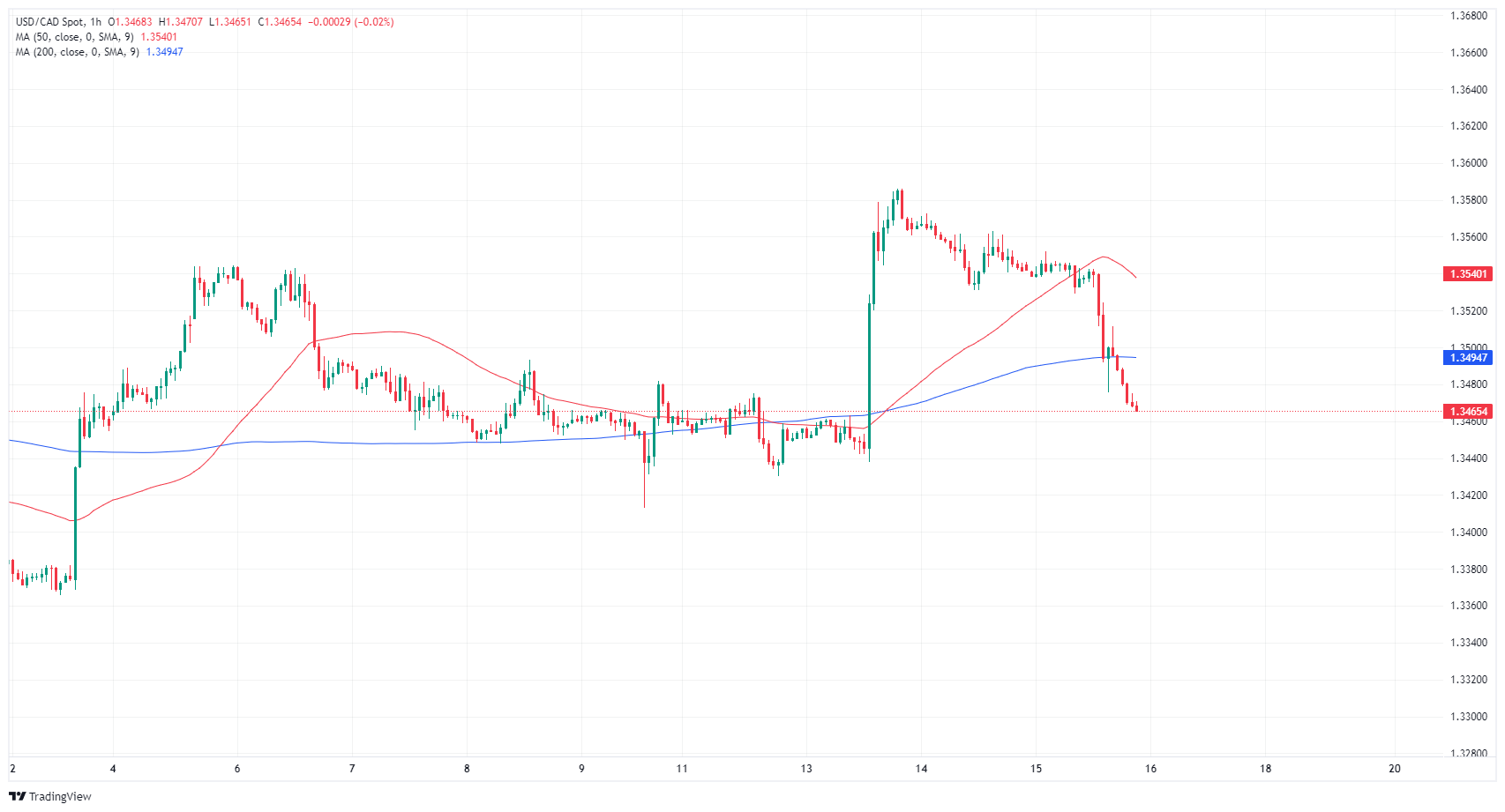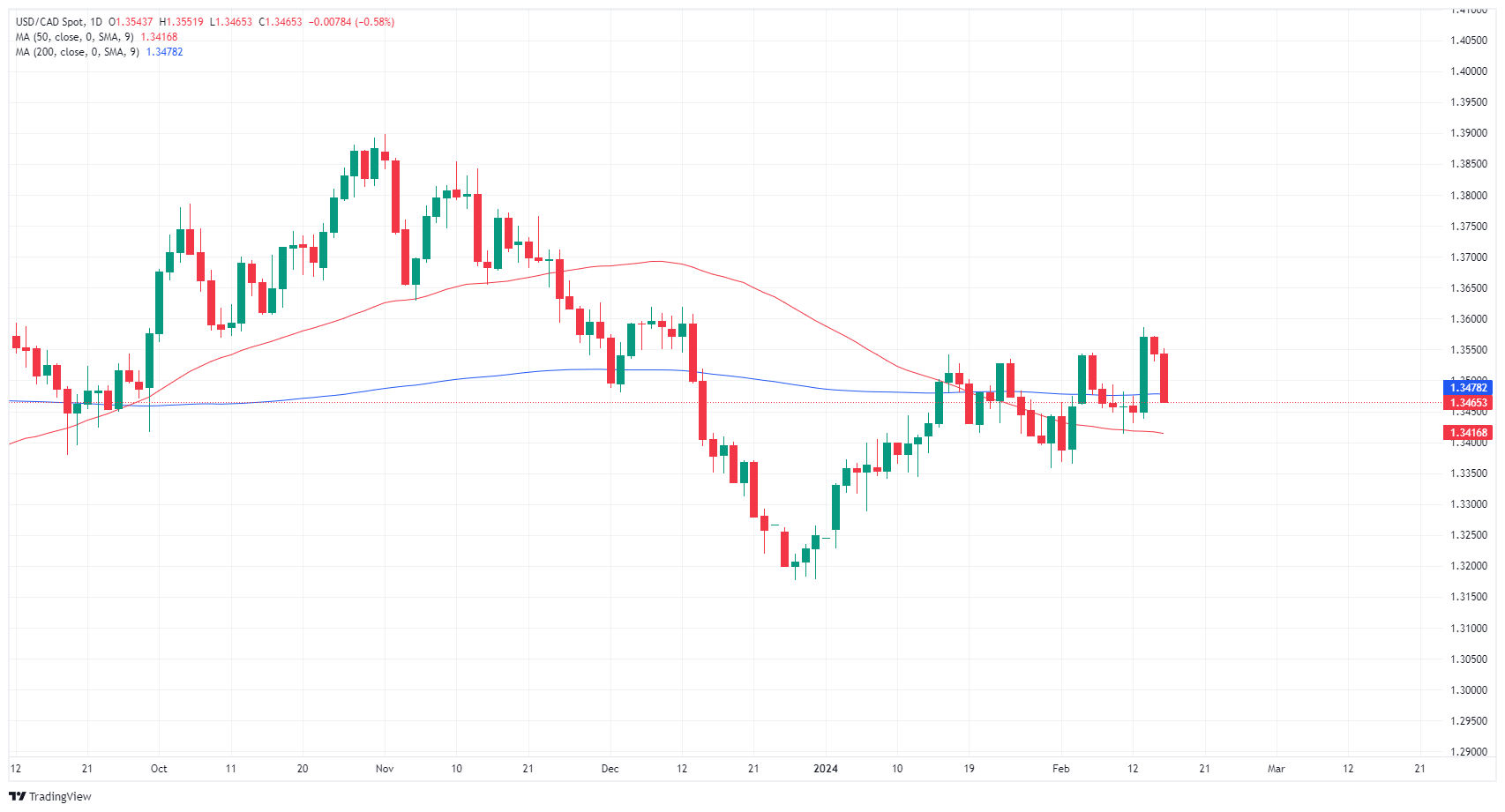Canadian Dollar finds footing after US Retail Sales miss deflates Greenback
- Canadian Dollar recovers ground on US data print.
- Canada sees low-impact data for the back half of the trading week.
- Crude Oil markets are in recovery mode, bolstering Canadian Dollar.
The Canadian Dollar (CAD) found itself on the high side of the US Dollar (USD) on Thursday after US Retail Sales missed expectations and shrank in January. The Greenback’s midweek surge on CPI-fueled risk aversion is getting pared back, and the CAD is finding additional support from recovering Crude Oil bids heading into the back end of the trading week.
Canadian Housing Starts came in below expectations, but the low-impact data saw little market movement as investors broadly focus on shifts in US data prints. A rebound in Crude Oil also bolsters the Canadian Dollar.
Daily digest market movers: US Retail Sales miss sparks Greenback weakness on Thursday
- US Retail Sales declined 0.8% in January, well below the -0.1% forecast.
- December’s US Retail Sales saw a downside revision to 0.4% from 0.6%.
- US Retail Sales excluding Autos also fell 0.6% MoM in January versus the 0.2% forecast.
- January’s US Industrial Production also fell 0.1% MoM versus the forecast of 0.3%, piling onto December’s 0.0% (revised from 0.1%).
- US Initial Jobless Claims printed at 212K versus the forecast of 220K for the week ended February 9, while the previous week saw a revision to 220K from 218K.
- Canadian Housing Starts settled to 223.6K for the year ending in January versus the 235K forecast, down even further from the previous period’s 248.9K (revised down from 249.3K).
- Crude Oil markets see a sharp recovery on Thursday after Wednesday’s stark decline.
- West Texas Intermediate (WTI) US Crude Oil barrels are back over $77.00, testing $77.50 during the US trading session.
- Friday is set to wrap up the trading week with US Producer Price Index (PPI) figures and the Michigan Consumer Sentiment Index.
- US PPI for the year ended January is forecast to tick down to 1.6% from 1.8%.
- The Michigan Consumer Sentiment Index for February is expected to improve slightly to 80.0 from 79.0.
Canadian Dollar price today
The table below shows the percentage change of Canadian Dollar (CAD) against listed major currencies today. Canadian Dollar was the strongest against the US Dollar.
| USD | EUR | GBP | CAD | AUD | JPY | NZD | CHF | |
| USD | -0.38% | -0.25% | -0.55% | -0.40% | -0.40% | -0.28% | -0.61% | |
| EUR | 0.37% | 0.10% | -0.18% | -0.02% | -0.03% | 0.10% | -0.22% | |
| GBP | 0.26% | -0.13% | -0.30% | -0.15% | -0.15% | -0.03% | -0.35% | |
| CAD | 0.55% | 0.17% | 0.30% | 0.15% | 0.15% | 0.27% | -0.05% | |
| AUD | 0.41% | 0.01% | 0.15% | -0.16% | -0.01% | 0.12% | -0.20% | |
| JPY | 0.40% | 0.03% | 0.13% | -0.15% | -0.01% | 0.12% | -0.20% | |
| NZD | 0.28% | -0.09% | 0.03% | -0.27% | -0.12% | -0.12% | -0.32% | |
| CHF | 0.60% | 0.23% | 0.35% | 0.06% | 0.21% | 0.20% | 0.32% |
The heat map shows percentage changes of major currencies against each other. The base currency is picked from the left column, while the quote currency is picked from the top row. For example, if you pick the Euro from the left column and move along the horizontal line to the Japanese Yen, the percentage change displayed in the box will represent EUR (base)/JPY (quote).
Technical analysis: Canadian Dollar claws back ground against the Greenback
The Canadian Dollar (CAD) recovered half a percent against the US Dollar on Thursday, while shedding about a tenth of a percent against the market’s strongest currency for the day in the Swiss Franc (CHF). The US Dollar is broadly softer in the back half of the trading week, giving the Canadian Dollar a leg up.
USD/CAD tumbled into an intraday low of 1.3475 on Thursday, and the pair is running into near-term technical support from the 200-hour Simple Moving Average (SMA) near 1.3494 as bids grapple with the 1.3500 handle.
Daily candlesticks continue to see friction from the 200-day SMA at 1.3478. Despite USD/CAD testing new highs consistently, progress has been thin as the pair threatens to tip into a consolidation pattern between 1.3400 and 13600.
USD/CAD hourly chart
USD/CAD daily chart
Canadian Dollar FAQs
What key factors drive the Canadian Dollar?
The key factors driving the Canadian Dollar (CAD) are the level of interest rates set by the Bank of Canada (BoC), the price of Oil, Canada’s largest export, the health of its economy, inflation and the Trade Balance, which is the difference between the value of Canada’s exports versus its imports. Other factors include market sentiment – whether investors are taking on more risky assets (risk-on) or seeking safe-havens (risk-off) – with risk-on being CAD-positive. As its largest trading partner, the health of the US economy is also a key factor influencing the Canadian Dollar.
How do the decisions of the Bank of Canada impact the Canadian Dollar?
The Bank of Canada (BoC) has a significant influence on the Canadian Dollar by setting the level of interest rates that banks can lend to one another. This influences the level of interest rates for everyone. The main goal of the BoC is to maintain inflation at 1-3% by adjusting interest rates up or down. Relatively higher interest rates tend to be positive for the CAD. The Bank of Canada can also use quantitative easing and tightening to influence credit conditions, with the former CAD-negative and the latter CAD-positive.
How does the price of Oil impact the Canadian Dollar?
The price of Oil is a key factor impacting the value of the Canadian Dollar. Petroleum is Canada’s biggest export, so Oil price tends to have an immediate impact on the CAD value. Generally, if Oil price rises CAD also goes up, as aggregate demand for the currency increases. The opposite is the case if the price of Oil falls. Higher Oil prices also tend to result in a greater likelihood of a positive Trade Balance, which is also supportive of the CAD.
How does inflation data impact the value of the Canadian Dollar?
While inflation had always traditionally been thought of as a negative factor for a currency since it lowers the value of money, the opposite has actually been the case in modern times with the relaxation of cross-border capital controls. Higher inflation tends to lead central banks to put up interest rates which attracts more capital inflows from global investors seeking a lucrative place to keep their money. This increases demand for the local currency, which in Canada’s case is the Canadian Dollar.
How does economic data influence the value of the Canadian Dollar?
Macroeconomic data releases gauge the health of the economy and can have an impact on the Canadian Dollar. Indicators such as GDP, Manufacturing and Services PMIs, employment, and consumer sentiment surveys can all influence the direction of the CAD. A strong economy is good for the Canadian Dollar. Not only does it attract more foreign investment but it may encourage the Bank of Canada to put up interest rates, leading to a stronger currency. If economic data is weak, however, the CAD is likely to fall.